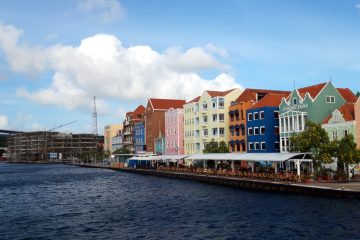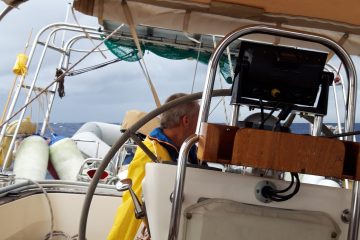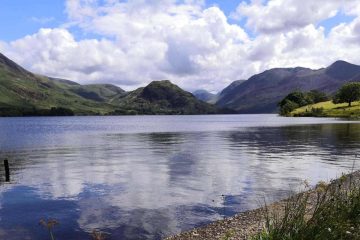Finally back in the Caribbean and again on “Maya”. Towards evening we reach Grenada and take a taxi back to Port Louis Marina. The air is filled with the chirping of cicadas and a warm scents waft over our faces reminding us of nutmeg and “weed” – the smell of Grenada!
Wonderful to be back here again. Our Italian friends Anita & Fred have already put on the lights in “Maya” to welcome us. They took care of “Maya” for the whole 3 months.
The next morning it’s time to clean up, unpack and dispose of various foodstuffs such as flour, pasta and spices in which small bugs have accumulated. They have even got into the muesli. Fortunately our other “pets”, the German cockroaches, are gone. Thank goodness for Boric acid!
We spend the next 2 weeks doing minor repairs. John installs a new “bladder” for the water pressure pump (a difficult and frustrating two day job). The welder welds us another reinforcement in the frame where the solar panels are attached.
A wonderful reunion with our Italian and German friends here in the marina.
In mid-September John’s sister Heather came for 3 weeks and we explored Grenada by car and boat.
Grenada did not achieve full independence from Holland until 1974. Before that there were bloody conflicts between the colonial powers England and France. About 110,500 people live on Grenada and up to 90% are of African origin. Tourism is the main source of income. The people here are incredibly friendly and actually always in a good mood. In the overcrowded minibuses plays loud and mostly African music or reggae . The minibuses always stop and you are always picked up as apparently the bus is never full!
Grenada is the “Spice Island” and everything revolves around the nutmeg. Wonderfully intense smell, a fresh nutmeg we could pick directly from the trees and still beautiful in their appearance. Grenada is agricultural varied and used not only for nutmeg trees but also cocoa trees and bananas are grown.
In the interior it is very mountainous and the volcanic origin determines the varied profile of the landscape. Several hikes followed to the great waterfalls like Concord, Seven Sisters and Annandale. The hikes led partly through dense rainforest with several river crossings.
In the Grand Etang National Park we made, together with our German friends Solvey and Achim, the ascent of the highest mountain “Qua Qua” with a height of just 723m. It was rather a muddy trail and neither of us had brought the right shoes for this.
We even saw the rare “Mona” monkeys here. At the moment it is very hot on Grenada 36C – 38C and this makes any activities a bit exhausting.
Grenada is also famous for the white long sandy beaches like the Grand Anse Bay. Of course we were also there and enjoyed the crystal clear water and white sand, and a Rum punch or two!
One of the highlights (at least for John) was a visit to the now abandoned “Pearls Airport” on the east coast of Grenada. Here there are two abandoned Soviet aircraft (both built by Antonov) – an old “Cubana Airlines” passenger aircraft and a single engine crop duster that was once a gift to Cuba from Russia.
Both aircraft are from the Cold War era and are the result of a misinformed American “invasion” of Grenada. The Regan government in the US apparently believed that a new airfield being built in the south of the island was for military use. Fearing that Russia was opening a supply route to Cuba for arms and ammunition, America invaded the island only to discover that the airfield under construction was in fact for civilian traffic (now the “Maurice Bishop” international airport).
Nevertheless both aircraft were “disabled” by the soldiers and left to rot. Sad as the twin turbo-prop airliner had arrived the day before and was waiting to leave.
The following day we had arranged with Solvey, Achim and Freddy to go diving in the anchorage “Long Point” where the Grenada Underwater Sculpture Park (see here: grenadaunderwatersculpture.com) is located. For us it was a bit difficult to go diving from the dinghy especially since we are still beginners. Unfortunately the visibility was not so good and the sculptures remained miraculously invisible. Fortunately, we had been there several times for snorkelling and had seen some of the impressive sculptures. The local artist Jason de Caires Taylor started in 2006 with the project to sink 80 life-size sculptures on the seabed in a depth of 6-8 meters so that corals will grow there again.
Since there are very few places on Grenada where you can anchor, we moored for a few days at a buoy in front of Grand Anse Bay. Fortunately we were mostly spared from the tropical storms that swept over the island in September – “Earl” to name but one.
We did not starve at our buoy, because fishermen came regularly and sold us lobster and tuna. The two large lobsters were fortunately already dead and would fit only with difficulty in my biggest pot. It was quite an experience to prepare the lobster and took almost the whole day. Pasta with lobster is simply super delicious.
After a few days in Prickly Bay at a buoy and ashore sampling the beer from a nearby brewery, Heather flew back home and we started our preparations for the upcoming trip to Curacao. These included having the boat lifted out and cleaned underneath – a job worth doing. Back at the buoy off Grand Anse, we went to dinner with Anita & Freddy one last time and stocked up on supplies. Our German friends Achim & Solvey had left previously and had already arrived safely on Curacao.



